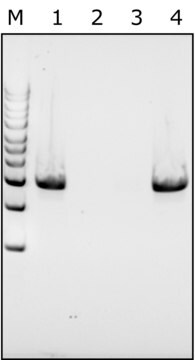L7386
Lisostafina from Staphylococcus staphylolyticus
≥500 units/mg protein, lyophilized powder
Sinónimos:
Endopeptidasa glicil-glicina
About This Item
Productos recomendados
product name
Lisostafina from Staphylococcus staphylolyticus, lyophilized powder, Protein 50-70 % by biuret, ≥500 units/mg protein
biological source
microbial (Staphylococcus staphylotyticus)
Quality Level
form
lyophilized powder
specific activity
≥500 units/mg protein
mol wt
25 kDa
composition
Protein, 50-70% biuret
packaging
pkg of (sold on basis of mg protein)
solubility
water: 2.00-2.10 mg/mL, clear to slightly hazy, colorless to light yellow
antibiotic activity spectrum
Gram-positive bacteria
application(s)
diagnostic assay manufacturing
diagnostic assay manufacturing
mode of action
cell wall synthesis | interferes
shipped in
wet ice
storage temp.
−20°C
¿Está buscando productos similares? Visita Guía de comparación de productos
General description
Biochem/physiol Actions
pH de actividad óptimo: ~7,5
Unit Definition
signalword
Danger
hcodes
Hazard Classifications
Resp. Sens. 1
Storage Class
11 - Combustible Solids
wgk_germany
WGK 3
flash_point_f
Not applicable
flash_point_c
Not applicable
ppe
Eyeshields, Gloves, type N95 (US)
Certificados de análisis (COA)
Busque Certificados de análisis (COA) introduciendo el número de lote del producto. Los números de lote se encuentran en la etiqueta del producto después de las palabras «Lot» o «Batch»
¿Ya tiene este producto?
Encuentre la documentación para los productos que ha comprado recientemente en la Biblioteca de documentos.
Los clientes también vieron
Protocolos
GenElute™ Bacterial Genomic DNA Kit protocol describes a simple and convenient way for the isolation of pure genomic DNA from bacteria.
Nuestro equipo de científicos tiene experiencia en todas las áreas de investigación: Ciencias de la vida, Ciencia de los materiales, Síntesis química, Cromatografía, Analítica y muchas otras.
Póngase en contacto con el Servicio técnico












